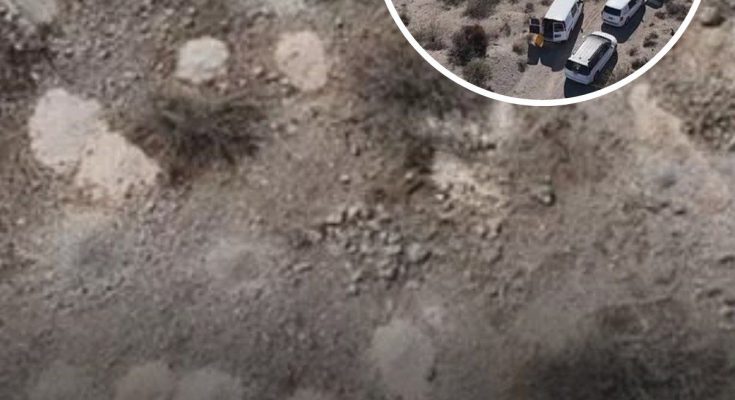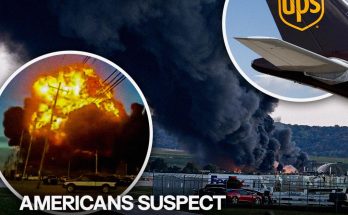Authorities in Nevada are investigating a macabre discovery in the Mojave Desert after more than 300 piles of cremated human remains were recovered from federal land south of Las Vegas, with officials saying the case likely involves illegal dumping by a commercial funeral business but offering no firm identification of those responsible. The Bureau of Land Management confirmed that the first discovery was made near the rural community of Searchlight on 28 July, about 55 miles southeast of Las Vegas, after a passerby alerted local media and law enforcement to dozens of ash mounds clustered off a dirt road. Federal agents later verified the material as human “cremains,” and the scope widened in late October when recovery teams said they had collected roughly 315 distinct piles, some found in a second nearby area, underscoring the scale of what investigators have called an unprecedented mishandling of the dead on public land.
The location—BLM-administered desert terrain alongside U.S. 95—became the focus of a joint inquiry involving the federal land agency and the Las Vegas Metropolitan Police Department after photographs obtained by local journalists showed small grey mounds scattered among low desert vegetation, along with items that appeared to be zip ties and fragments consistent with a broken urn. Through August, officials were cautious on numbers, describing “up to 70” piles while analysis proceeded. By the end of October, however, a coordinated recovery led by Palm Mortuaries and Cemeteries counted approximately 315 piles, with the company stating the remains would be interred together in a downtown Las Vegas crypt so families would have a place to visit. The BLM has not named a suspect and has not released further forensic detail beyond the confirmation that the material is human; the agency has said the investigation is active.
In interviews reported by Las Vegas outlets and national follow-ups, Palm’s president, Celena DiLullo, said the recovery team’s priority was to treat the deceased with dignity after what appeared to be a large-scale dumping that left no identifiable tags or paperwork in the ash. “I think it’s important to us to make sure that these people are not forgotten and not left. It’s important to our community and our profession that we demonstrate how much we do care about these people,” she said, adding that the remains would be placed in a crypt to allow loved ones to mourn even if identification proves impossible. “I don’t know if it was the wishes of these people to be out,” she said of the desert setting, noting the lack of traceable information in the recovered piles.
Officials have repeatedly drawn a distinction between Nevada’s permissive rules for individuals who scatter ashes and the federal land manager’s restrictions on commercial activity. State law does not bar a person from scattering cremated remains on public lands or waters. BLM guidance, however, allows scattering by individuals while barring funeral homes from making “commercial distribution” of cremated remains on federal land, a policy that investigators and outside experts say would be implicated if a business offloaded dozens or hundreds of sets of ashes as part of its operations. That premise—permitted personal scattering versus prohibited commercial disposal—has shaped the inquiry since August and is central to the theory now being tested by federal agents and police.
The July tip that launched the case described a tableau of ash mounds amid scrub and rock, some accompanied by plastic cable ties of the type funeral homes use to secure bags and urns, and a shattered urn that appeared to have been discarded. Those details, investigators said, were consistent with cremated remains handled in bulk before being deposited without ceremony, and they prompted questions among regulators and the death-care industry about whether the desert site had become a dumping ground for a mortuary seeking to avoid costs. As the story gained national attention, multiple outlets noted that sources close to the inquiry believed a commercial operator that had closed recently might be connected, though no business has been publicly named and a representative for one out-of-state company reportedly denied any role. Officials also stressed that the piles were not linked to a Las Vegas funeral home shut down in August on unrelated grounds.
With the site secured and recovery underway, the practical challenge has shifted to respectful disposition and public communication. Palm Mortuaries told local reporters it would place the roughly 315 recovered sets of cremains into a cemetery crypt in Las Vegas, a solution that acknowledges the near-impossibility of individual identification while providing a fixed place for remembrance. The plan follows common practice in mass-recovery scenarios where remains lack identifiers, allowing families who suspect their relatives’ ashes were mishandled to hold services and visit a dedicated interment point even if definitive ties cannot be drawn. DiLullo’s explanation—“to make sure that these people are not forgotten and not left”—matched the company’s approach, which involved bagging each pile separately and transferring them from the desert to the mortuary for interment.
For investigators, the timeline remains straightforward even as the motive and actors do not. A member of the public encountered dozens of ash mounds on 28 July; local television shared images that accelerated federal involvement; the BLM verified the material as human remains and opened a case with Metro police; and, in late October, a mortuary conducted a multi-day recovery that expanded the known count above 300 and revealed a second nearby patch. The most recent official comments from federal authorities have been limited to confirming that the matter is open. “This remains an active investigation, and we don’t have additional information to provide at this time,” a BLM statement to a Las Vegas outlet said on 31 October, the same day the recovery concluded.
The legal questions center on jurisdiction and intent. Because the dumping occurred on federal land, any violation would be processed under BLM rules and relevant federal statutes governing use of public lands, while potential state offenses could include unlawful disposal or commercial littering depending on evidence about who transported and released the ashes. The absence of identifiable fragments in the recovered cremains—no tags, no labels, no urn plates—complicates both victim identification and any effort to tie the material to specific cases handled by a business. That lack of traceable detail is one reason federal agents and police have refrained from naming suspects, instead urging tips while emphasizing that individual families who lawfully scattered ashes would not be targets of enforcement.
Public reaction has ranged from shock at the number—an eventual count of about 315 separate piles—to anger that any funeral operator would treat cremains as refuse. The desert terrain around Searchlight is crisscrossed by dirt roads used by off-roaders and utility crews; officials have not said whether trail cameras or vehicle tracks offered investigative leads. The case’s visibility grew as images circulated showing the mounds against the scrub, tapping into long-standing sensitivities in a region where memorials and scatterings on open land are common. The promise to inter the recovered cremains together, and to publicize the crypt location once the case allows, has been presented as a partial remedy while the search for whoever dumped the ashes continues.
From the outset, officials and reporters have taken care to underline what the case is not: it is not the discovery of newly deceased bodies or clandestine burials; the material is cremated remains, the pulverized bone fragments that remain after lawful cremation. It is also not, according to investigators, a one-off scattering by a family or small group. The presence of hundreds of discrete ash piles, consistent with individual cremations, and the recovery of ties and urn remnants support the working theory of bulk mishandling tied to a commercial process. That working theory is what distinguishes a potential federal violation from a permitted personal act under state law.
The timeline of public disclosures helps explain the evolving numbers that have appeared in coverage. When the BLM first acknowledged the discovery in late August, officials cited “up to 70” piles based on early imagery and site checks, a figure carried in wire reports. As teams returned with recovery gear in late October, they identified more piles and a second cluster within proximity of the original, producing a final count of about 315 that the mortuary relayed to local newsrooms. The arc from 70 to more than 300 reflects that broader search rather than a sudden new dump, according to coverage that quoted Palm’s president and summarized BLM updates.
In practical terms, the interment plan means the scattered ash will be unified in a single urban resting place, a move the mortuary framed as a way to “demonstrate how much we do care about these people” after an episode that, in the company’s words, ran counter to the profession’s standards. The approach may also aid investigators if a business is eventually tied to the desert site: families who suspect mishandling could come forward, and any restitution or regulatory action could be linked to a known crypt containing the recovered material. For now, though, federal agents have not announced civil or criminal charges, and the BLM has kept its updates terse to avoid prejudicing the inquiry.
The episode has prompted renewed scrutiny of oversight in the funerary sector, a topic that has surfaced nationally in recent years amid unrelated cases of negligence and mishandling. In Nevada, regulators rely on a licensing board to monitor funeral homes and crematories, with federal land managers overseeing activity on public lands. The alleged use of BLM terrain for a mass disposal sits at the intersection of those regimes. While the BLM’s policy is clear on commercial scattering, establishing who deposited the ashes, when the trips occurred, and what business records might still exist are all tasks that investigators must complete before any enforcement can be contemplated. That process has unfolded largely out of public view since August.
The broader context matters for families who scatter ashes on hiking trails, ridgelines and lake shores across the West—a widespread practice that, when done by private individuals, typically involves small quantities and leaves little trace. The desert scene near Searchlight, by contrast, presented as an industrial pattern: pile after pile placed along a drivable track, with residual materials suggestive of a back-of-house process rather than a personal ceremony. It is that contrast that has driven the “horror” language in some headlines and the cautious tone in official statements, which have focused on the verifiable: human cremains, federal land, a large count, and an ongoing investigation with no named suspect.
What happens next is largely administrative unless and until investigators identify a responsible party. Palm Mortuaries has said the recovered cremains—each kept separate during collection—will be interred in a crypt at the company’s downtown cemetery. Local outlets indicated that the exact crypt location would be shared publicly at a later stage so relatives can pay respects. The BLM, for its part, has reiterated that it will release new information only when the investigation permits. In the meantime, the desert site has been cleared of visible remains, and the agency has not disclosed whether environmental sampling or additional searches are planned in adjacent washes or road spurs.
For the Las Vegas area, the case adds to a year of high-profile law enforcement stories while touching a more intimate civic nerve: the expectation that the dead be treated with care. The promise of a collective interment is a gesture toward that standard after a discovery that, by officials’ accounts, fell far short of it. The facts that can be stated with confidence are stark and few: a July sighting of dozens of ash mounds; an August confirmation that the material was human; a late-October recovery effort that brought the count to about 315; and a federal investigation premised on the likelihood that a commercial operator used public land to discard cremains. Everything else remains a matter for the agents now combing records and the mortuary professionals preparing a crypt for the anonymous dead.



